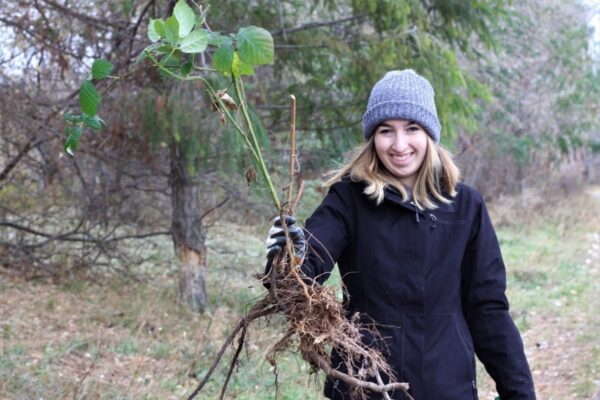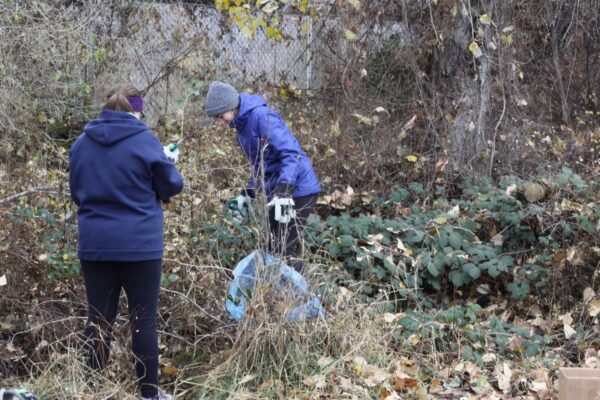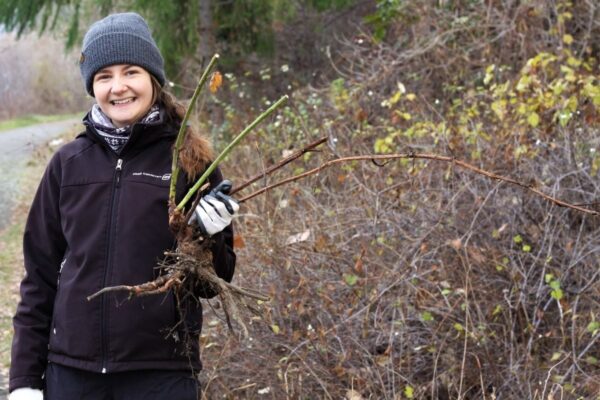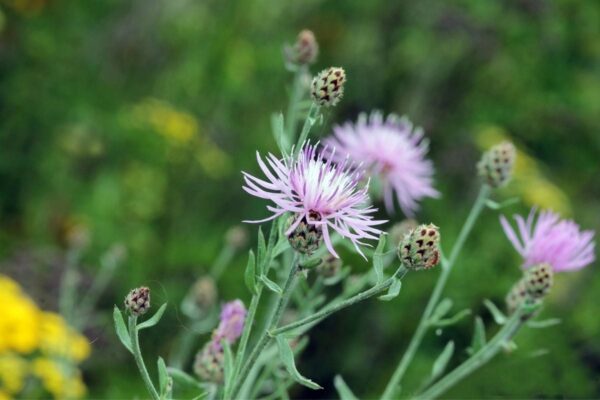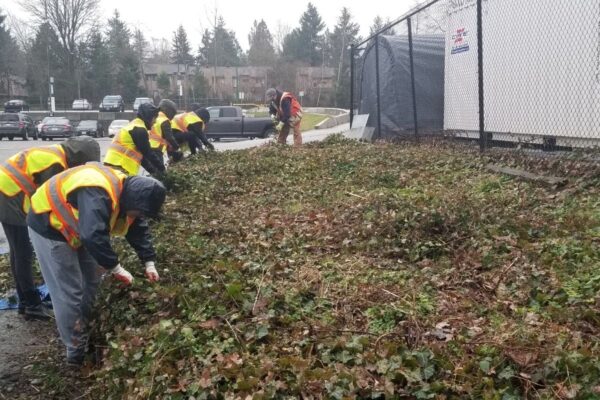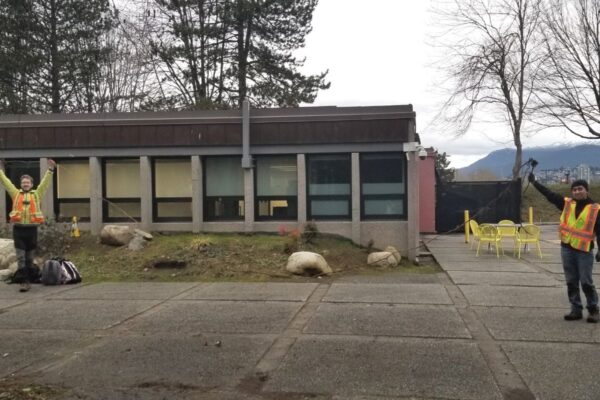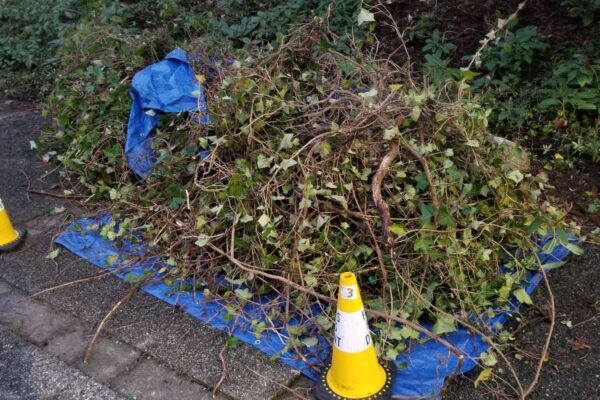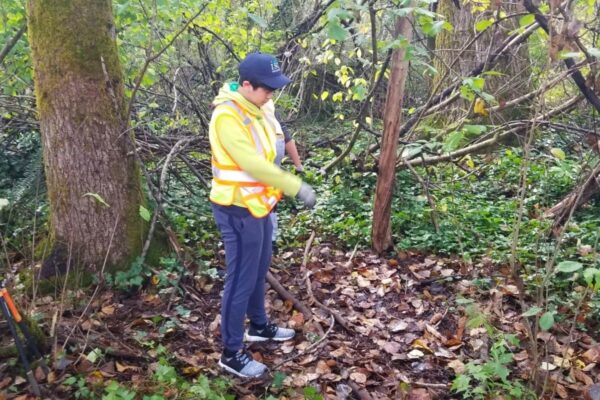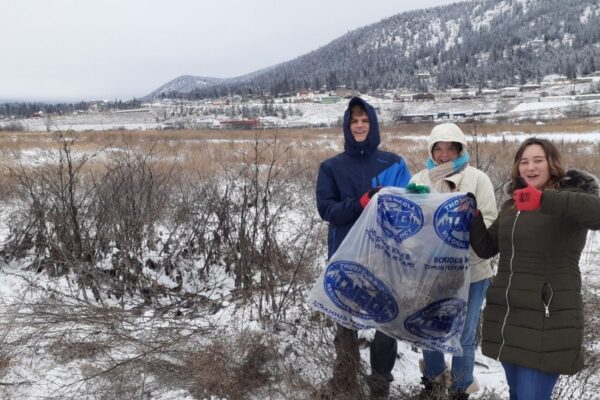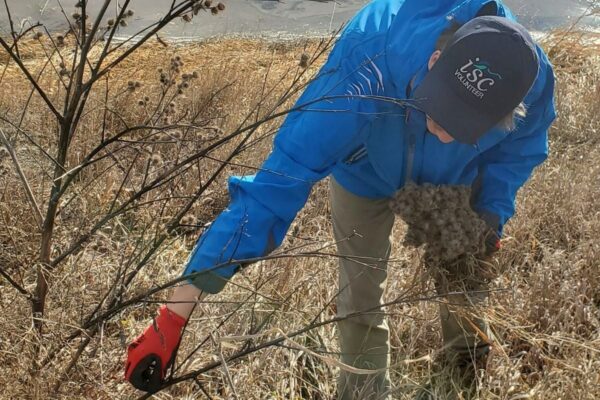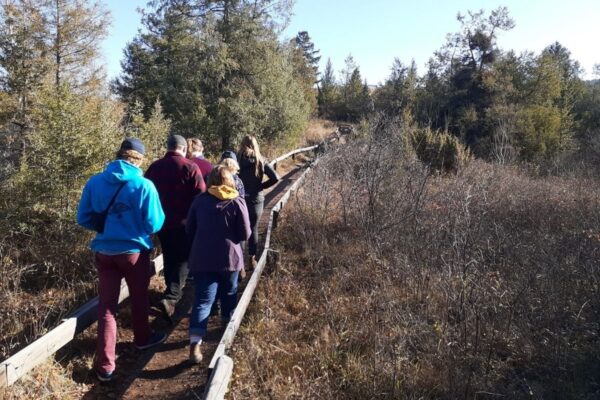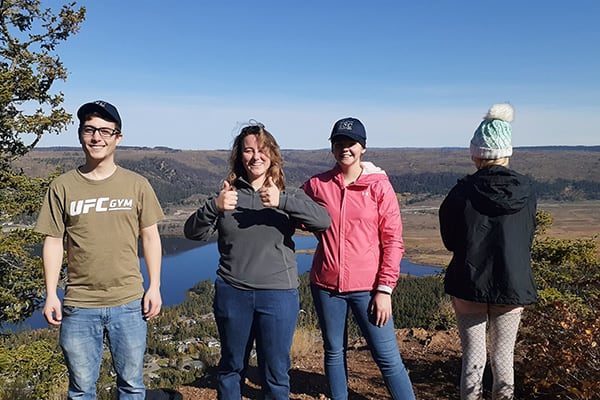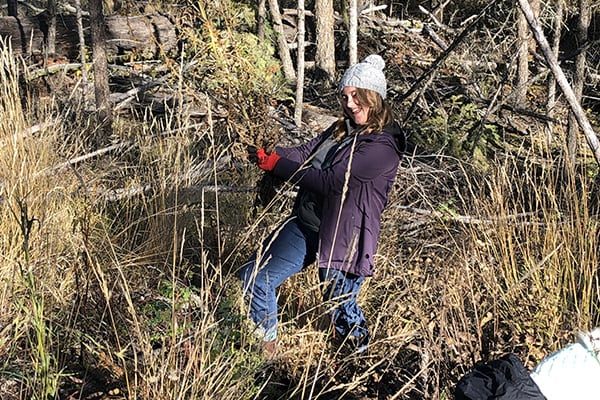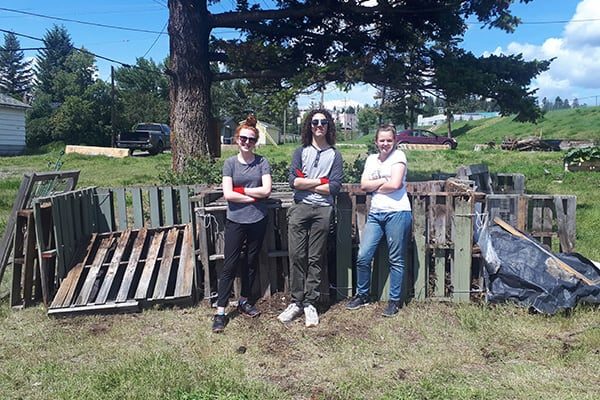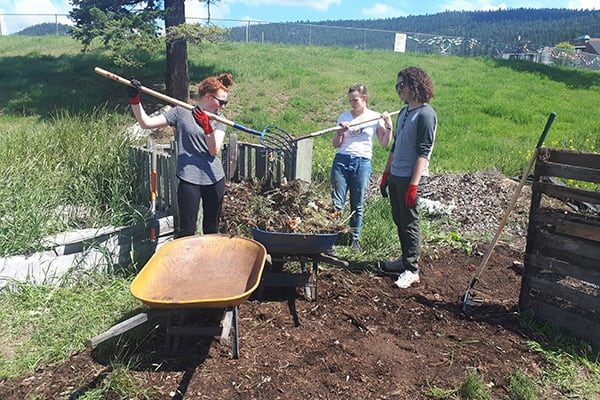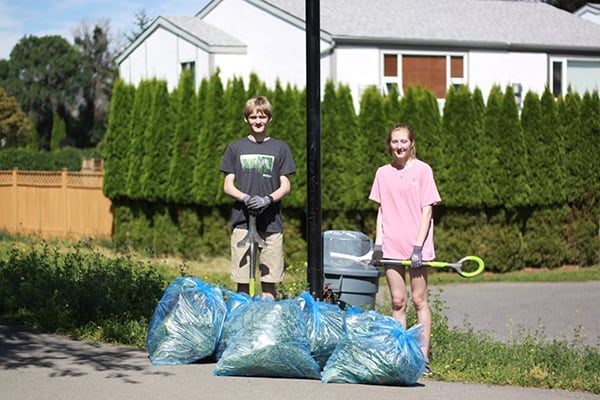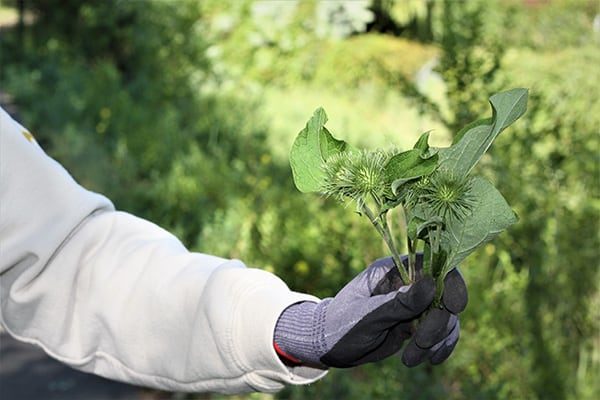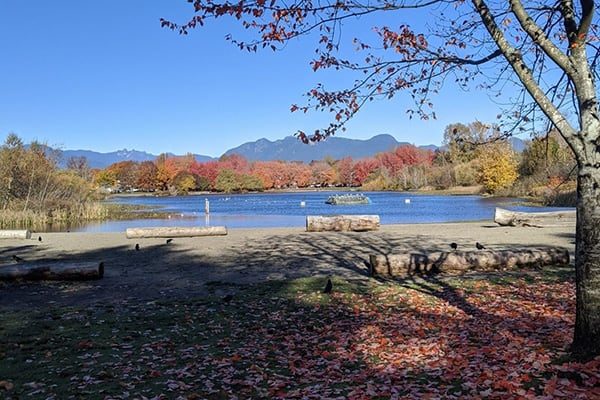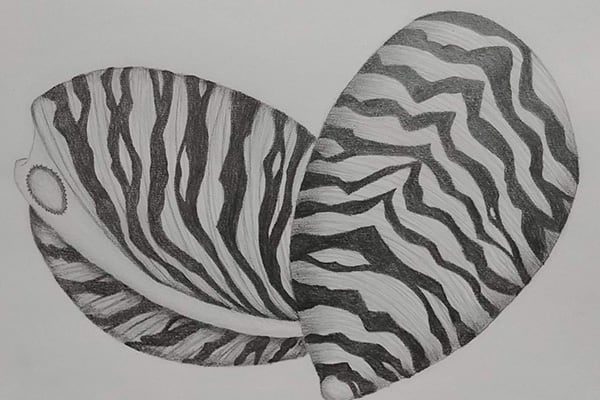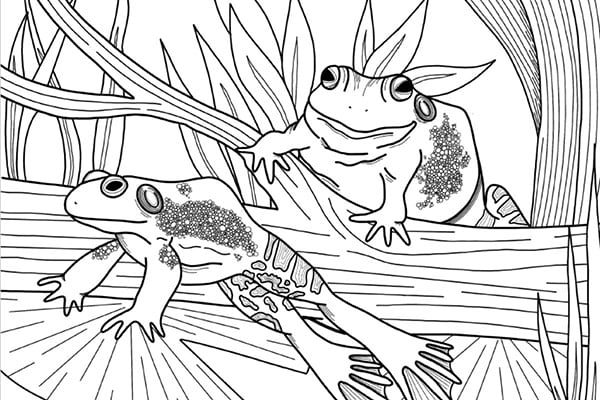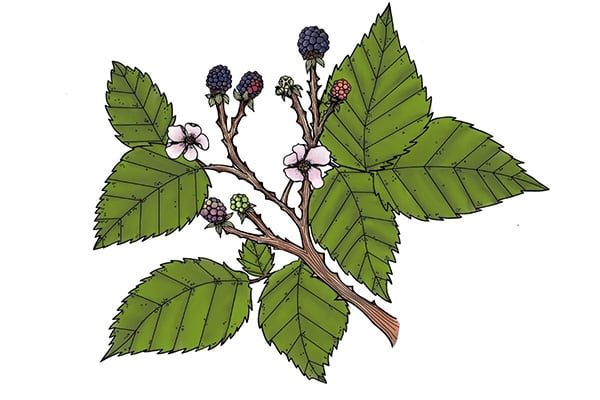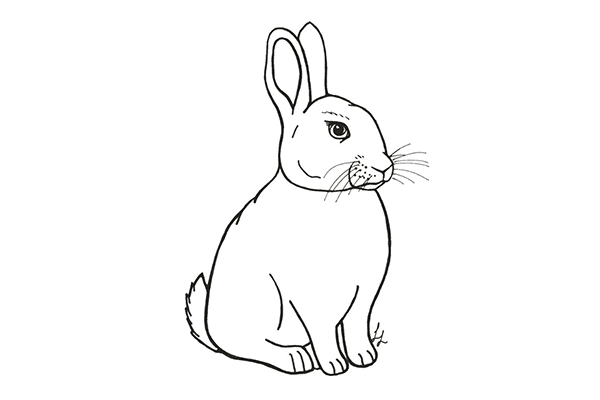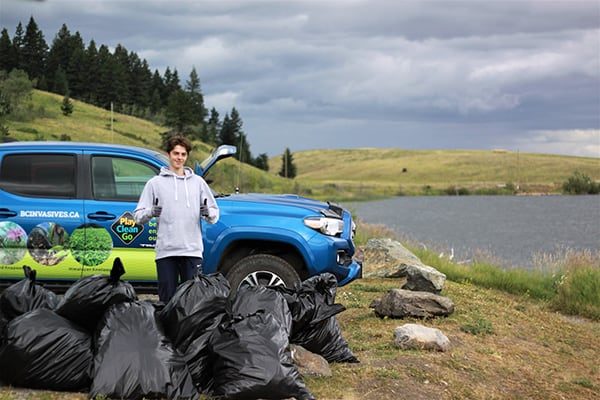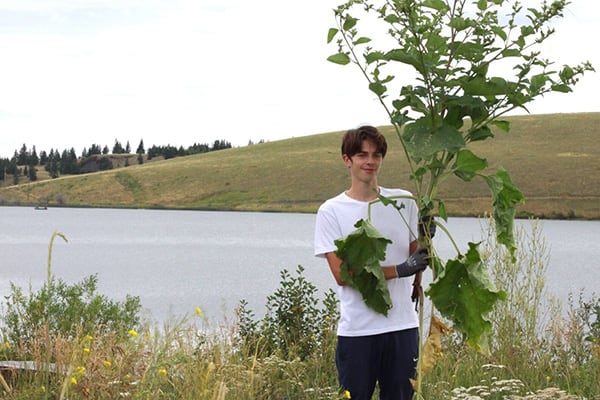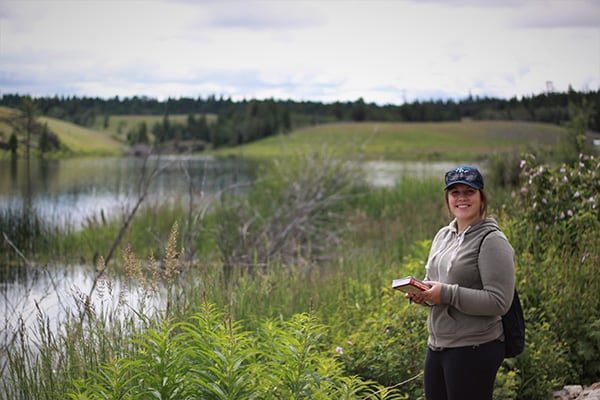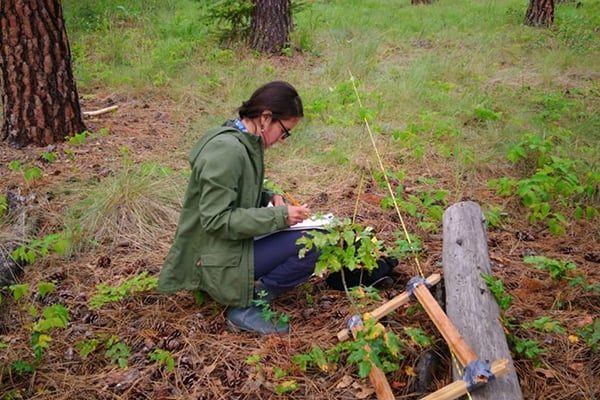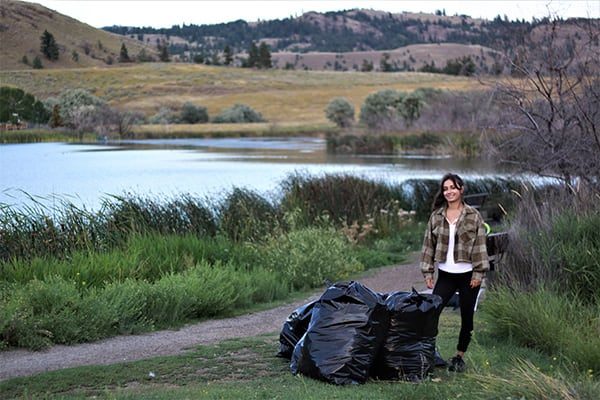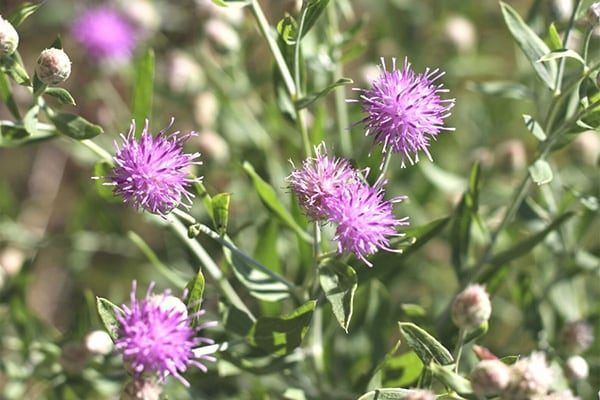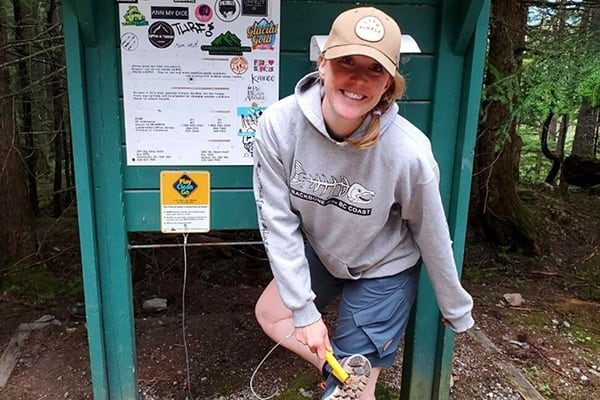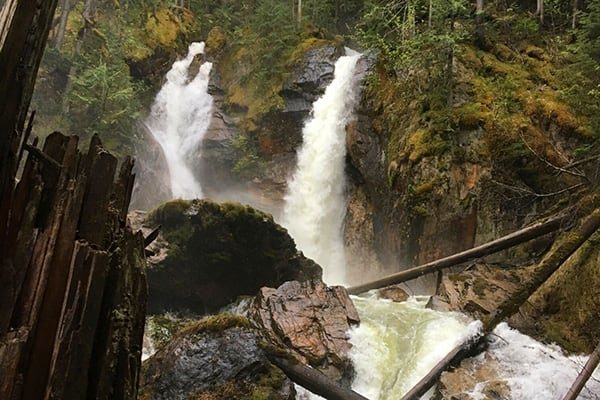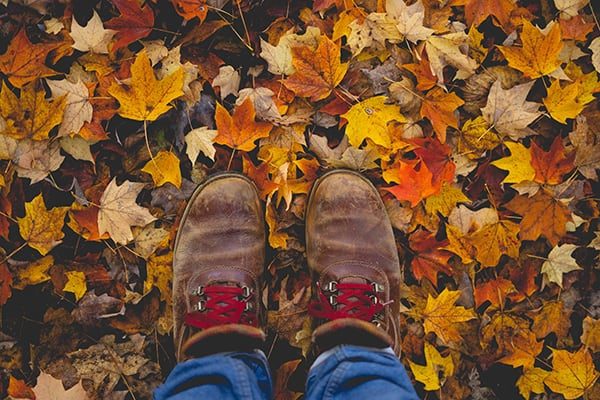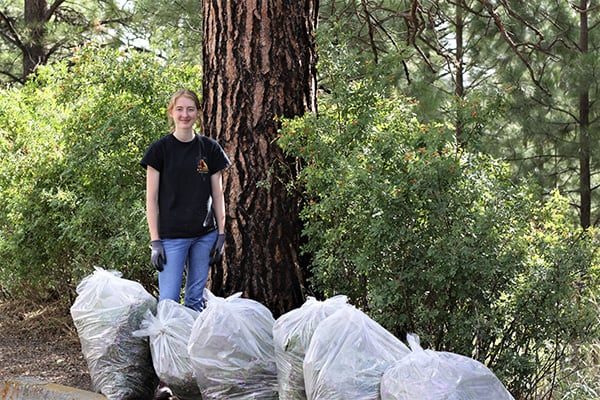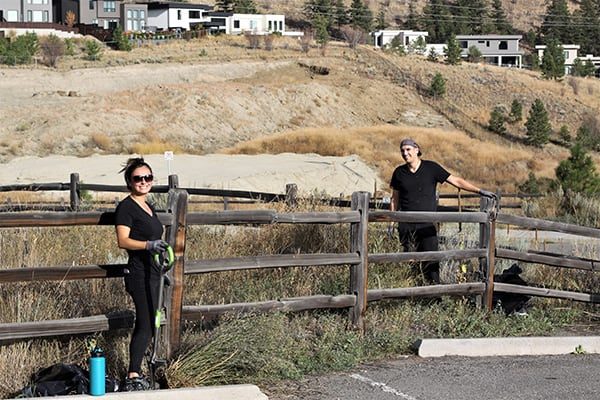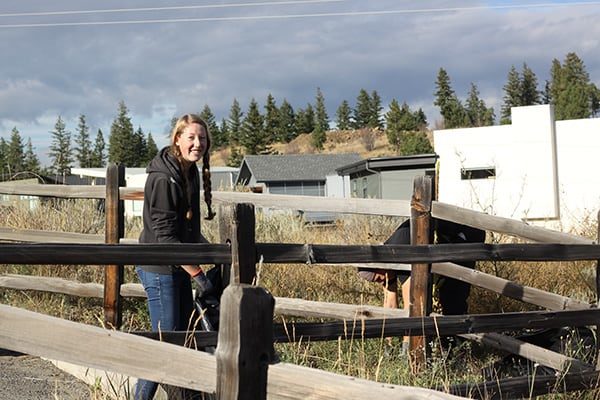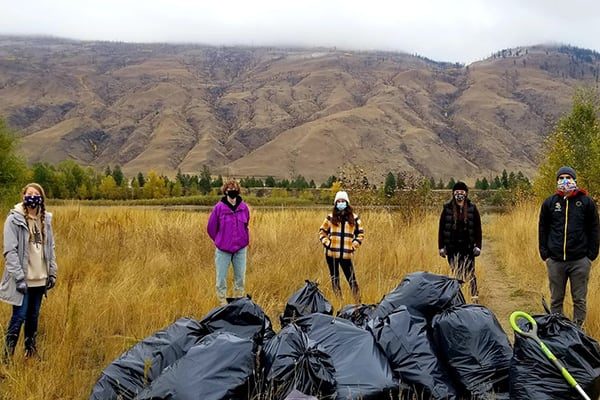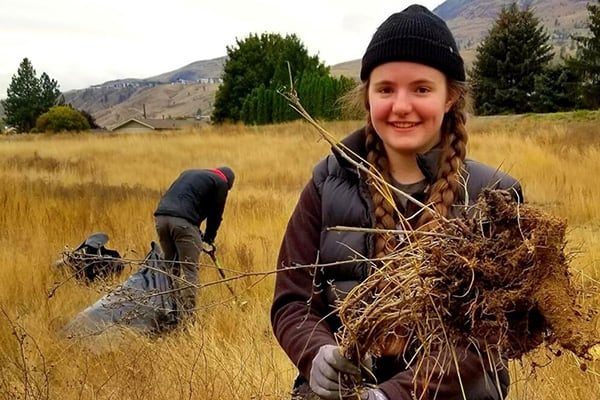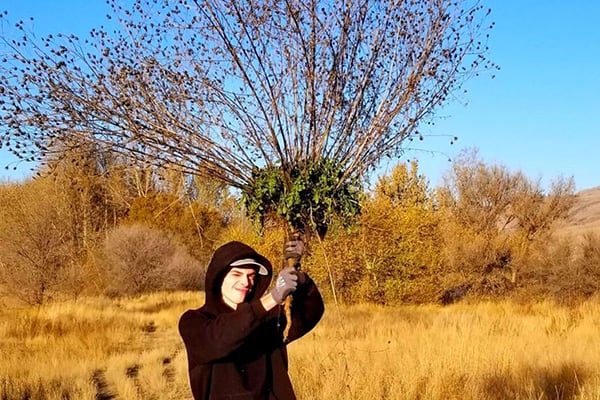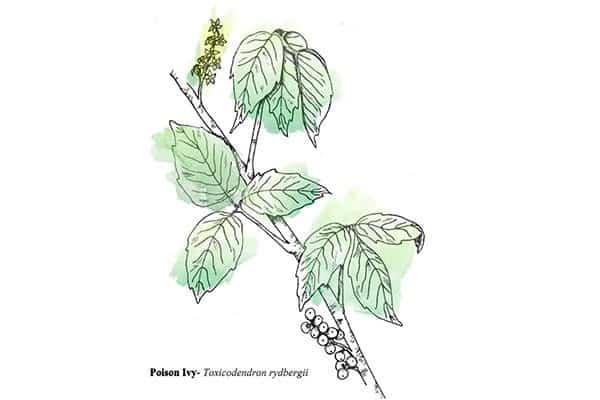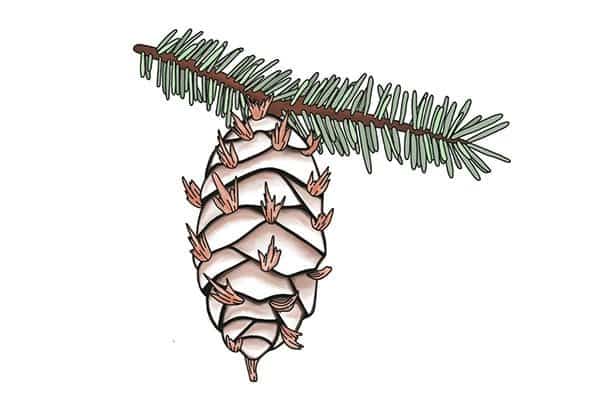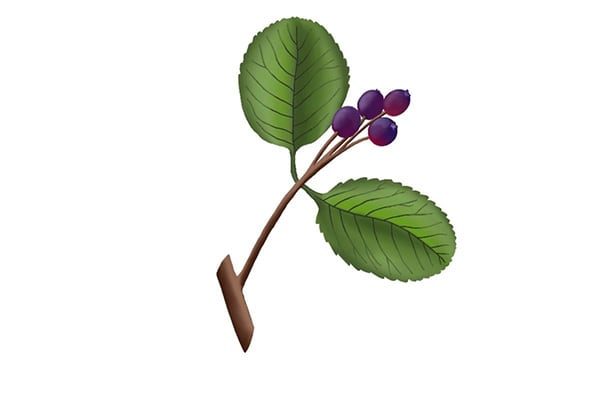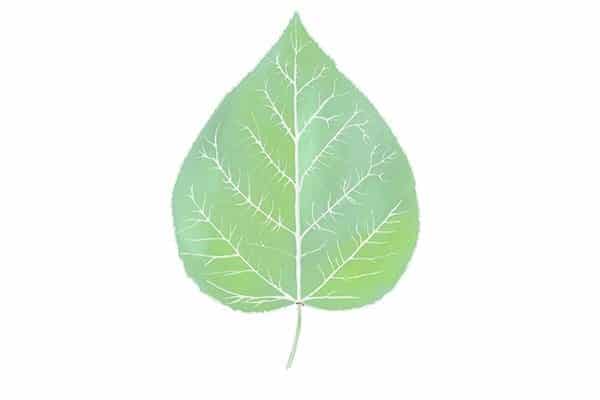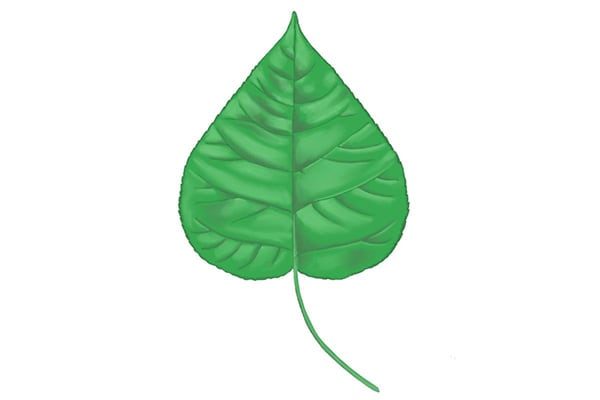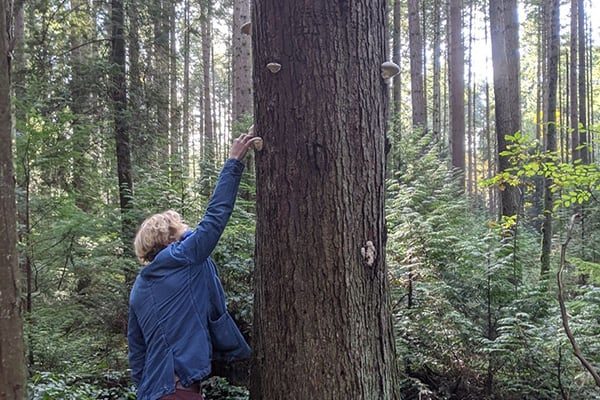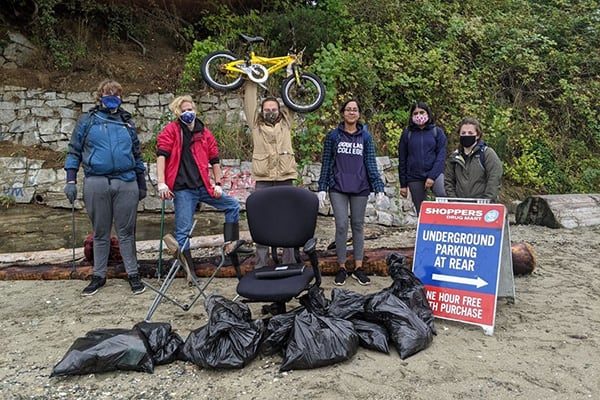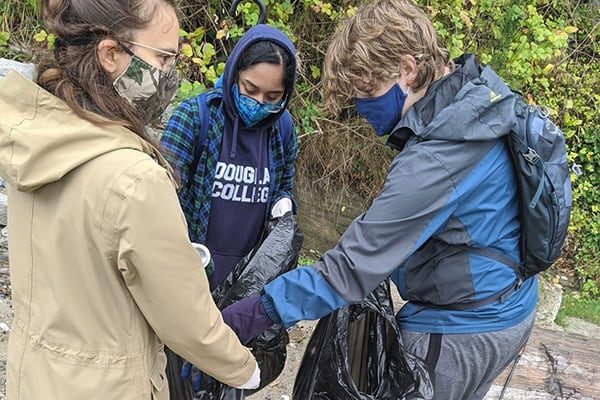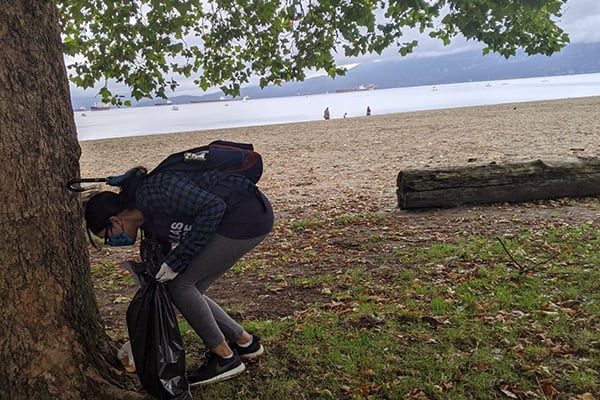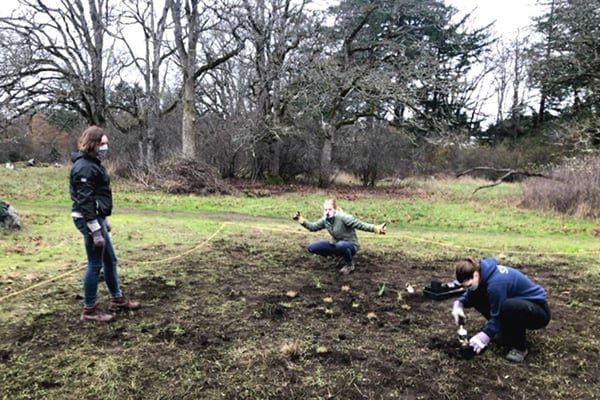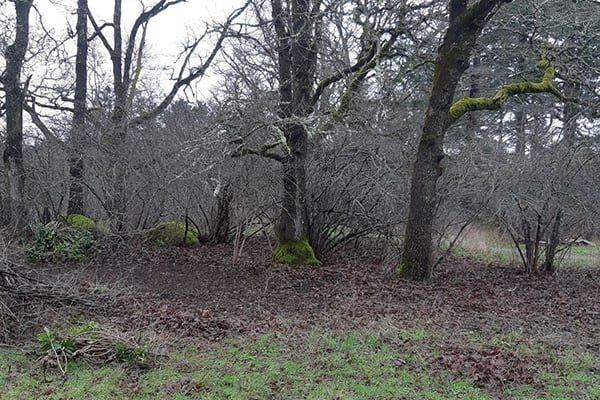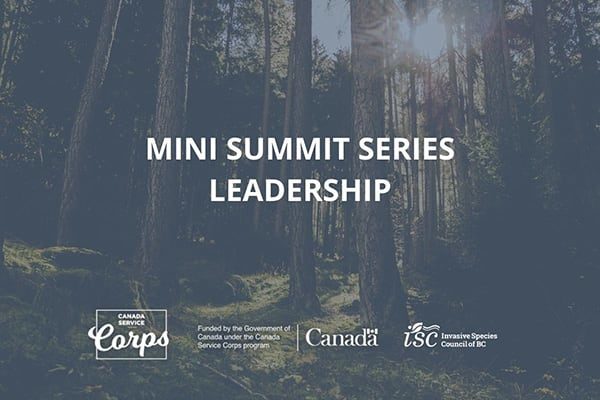Volunteer Projects
Yellow flag-iris (Iris pseudacorus) is an eye-catching perennial that creates dense stands in wet areas, excluding native wetland species and threatening plant and animal diversity.
Learn moreAs a volunteer you can make a big difference in your community.
We welcome volunteers from all walks of life who bring different skills and experience. We support our volunteers to explore a diverse range of initiatives, whether they’re outside in the field with their team, getting creative behind a computer screen, or taking action in their own backyard. Check out our volunteer projects across the province.
Recent Projects
October 31, 2019 – ongoing
Volunteers surveyed the Nature Trail and Disc Golf Course at McArthur Island Park where over five different types of invasive plants were identified and mapped. Inspired by their findings, the volunteer team is continuing to conduct weed pulls at the park to remove Burdock and Himalayan blackberry – a tiring but rewarding project that is making a lasting impact!
October 17, 2019 – November 18, 2019
Volunteers surveyed the entire 106 acres of the BC Wildlife Park in search of invasive species! Over 15 different types of invasive plants were identified and mapped. Volunteers took part in several weed pulls removing over 60 garbage bags of invasive species from the park. Stewardship continued with volunteers organizing a nature walk, learning to identify several invasive and native plant species. Lots of energy has been spent on this project and motivation continus for future work in the area.
September 21, 2019
With the recent introduction of spotted knapweed to the relatively invasive-free community of Sunpeaks, the Kamloops Volunteer group were invited by invasive plant expert Catherine Tarasoff to help with a weed pull. The group tackled one of the only spotted knapweed sites in the area, which was a great experience and opportunity to make real impact to the local environment.
September 1, 2019 – March 1, 2020
Moscrop Secondary School Science 10 students and ISCBC volunteers took part in environmental stewardship on BCIT’s South Campus, which was in definite need of some attention! With the support of BCIT staff and students, youth volunteers removed invasive species and took part in ecological restoration activities to improve the biodiversity and function of the on-campus urban forest. For many of our volunteers, this project was their first experience with community service and ecological work. This was a great launching pad for future volunteering in this community.
October 5, 2019 – ongoing
The Noons Creek Salmon Hatchery is a volunteer-run facility that raises Coho and Chum salmon within parkland owned by the City of Port Moody. Much of the parkland’s riparian area (beside rivers and streams) is impacted by invasive English ivy and English holly making this an ideal site for environmental stewardship. Volunteers are taking part in an ongoing self-directed weed pull to help restore the habitat. Volunteers learn about plant identification and safe removal of invasive plants, and how special disposal sites allow people to remove invasive species without risking spread.
October 1, 2019 – July 1, 2020
Scout Island is a little piece of nature in the middle of Williams Lake with easy access to the general public for walks, bird watching, swimming and much more. The island is on a migratory path for many species of birds adding to the importance of healthy habitats. ISCBC volunteers in Williams Lake area surveyed on and around Scout Island to identify sensitive habitats and priority sites for weed pulls and information posts. Volunteers conducted several weed pulls at this site, returning this beautiful park back to a more natural state.
October 6, 2019
Volunteers tackled invasive species along Russet Bluffs, a beautiful hiking area ten minutes outside of Williams Lake. The popularity of the bluffs with hikers has resulted in invasive species introduction. Volunteers in the Williams Lake area surveyed the trail and located a large patch of bull thistle which they managed to pull! They also found an ideal spot at the trail head to place Play Clean Go signage and a boot brush to help trail users give invasives the brush off.
September 29, 2019 – February 25, 2020
A group of movitaved volunteers were sad to discover that Williams Lake does not have proper composting facilities for the public to use. To reduce the possibility of the public trying to compost invasives, the volunteer group set up a composter with informational signs explaining how to (or not to) compost invasive species. This has been a great way to boost awareness and make this local habitat much healthier for future generations.
July 25, 2019
The Rivers Trail is a popular walking, cycling and running path that borders the North and South Thompson River and winds around McArthur Island Park. This trail borders sensitive riparian habitat that has unfortunately been infested with several invasive species. In this summer project, volunteers braved the mosquitos and removed several bags of Common burdock and Knapweed.
December 1, 2019 – ongoing
Volunteers in Kamloops are bridging the gap between science and art by creating artistic invasive species projects which help spread awareness of invasive species and their impacts! These impressive art projects come in the form of colouring pages, posters, water colour prints, and more, all showcasing the diverse visual aesthetics of invasive species and their unique identifiers. We are looking forward to seeing more volunteer art projects!
July 8, 2020 – August 6, 2020
Edith Lake is a popular fishing and camping spot 30 minutes outside Kamloops. Volunteers surveyed the site where they found several invasive species and learned to identify native species. Dedicated volunteers returned to the site and removed invasive species from the day use area, a popular fishing spot. This project was a great way for volunteers to build their knowledge of plant identification and make a postive impact in their community.
July 25, 2020
Mabel Lake is a popular lake for a variety of water-based activities. Youth volunteer, Jennifer, conducted a site inventory at the Mabel Lake Provincial Park, recording the invasive species present, growing her skills in species identification and laying the ground work for future restoration in the area.
July 27, 2020 – October 10, 2020
Albert McGowan Park is a popular community park that is also home to Gambles pond – an important wetland habitat to waterfowl, amphibians and reptiles. Volunteers conducted a site survey, with several invasive species found on site including Russian knapweed. Volunteers returned to the site several times, removing over 40 garbage bags of invasive species and educating many park visitors at the same time!
August 2, 2020
Begbie Falls is in the heart of BC’s interior rainforest. It is a popular recreation site, frequented by mountain bikers, nature lovers and camping enthusiasts. Seeing the potential for invasive spread, ISCBC volunteer Hannah tackled stewardship head on. Volunteers returned to this unique location over several months, conducting an invasive plant survey, removing invasive plants and cleaning up garbage along the trail! Hannah plans to return next spring to continue this project.
August 8, 2020
Monck Provincial Park is a popular campsite for families who enjoy many outdoor activities including hiking, swimming, fishing and boating. Volunteers participated in a weed pull removing a whopping six bags of Spotted knapweed!
July 27, 2020
Park Hill is a beautiful trail located near Salmon Arm. The trail brings the community together for nature walks, bird watching, and mountain biking. ISCBC volunteers conducted an invasive plant survey and will be returning to monitor for invasive species at this popular recreation site.
October 6, 2020 – ongoing
Kenna Cartwright Park is a popular hiking and dog walking spot for Kamloops residents. Volunteers worked tirelessly to remove over 20 bags of invasive plants from this site and will continue their work in this ongoing stewardship project.
August 30, 2020
Green Timbers Urban Forest is an expansive pocket of forest that provides recreation opportunities, wildlife habitat and more. Volunteers took the day to explore this dense habitat, connect with the land and learn about the diverse species that make up the ecosystem. Volunteers left inspired and motivated to not only protect this area, but work to make it a healthier habitat for generations to come.
August 27, 2020
Mundy Park is a remarkably intact forest full of aquatic habitat for various species including the endangered Western painted turtle. Volunteers were excited to learn about the nature of this park as they explored the area while soaking in the physical benefits of an explorative walk. Volunteers also worked on identifying invasive plants and discussed the steps needed to engage in ongoing protection of the land.
August 23, 2020
Richmond Nature Park boasts extensive bog habitat and produces blueberries and cranberries when in season. The peat beneath the bog is one of the best natural carbon sinks found anywhere on earth. Volunteers learnt about this extensive ecosystem, shared knowledge about habitat restoration and took inventory of their incredible surroundings. This project was a true reminder of the importance of restoration work and protecting healthy habitats!
August 16, 2020
Lower Seymour Conservation Reserve is a popular recreation area with mountain peaks, hydroelectric dams and dense coastal forest. As a source of drinking water for the Metro Vancouver region, this reserve acts as a classroom, natural resource, recreation destination and a deep well of biodiversity. Volunteers explored their connection to people and place, while taking inventory of the vast ecosystem around them. They left feeling inspired, motivated and eager to continue their work as environmental stewards!
October 1, 2020 – ongoing
Westsyde Centennial Park is a beautiful spot to walk along the North Thompson River, visited by locals to enjoy a variety of recreation activities. Volunteers have removed over 40 bags of Spotted knapweed from this sensitive riverside habitat, making room for native species to thrive again. Volunteers took the opportunity to share their passion for stopping the spread of invasive species with park visitors. The volunteers plan to return to the park in the spring to continue their stewardship.
July 1, 2020 – ongoing
Volunteers have been hard at work learning about native plants found in the Kamloops region for the development of a local resource. They have written interesting and informative plant descriptions and have created beautiful botanical illustrations. Youth volunteers plan to share the finished pamphlet with other youth to inspire them to learn about their local environment, grow their knowledge and take action in their communities.
September 21, 2020 – ongoing
ISCBC youth volunteers headed to South Surrey to visit a land rehabilitation project, led by Matcon Construction. Volunteers from across the Lower Mainland had the rare opportunity to learn and connect with professionals from land rehabilitation and waste management industries, who are making major strides in the environmental world. Volunteers were led on a tour through the site and learned about the great work the team was doing to restore this valuable ecosystem, which is showing incredible signs of recovery since invasive species were removed. Volunteers ended the day by helping pull invasive English ivy growing in one section of the rehabilitation site. Taking part in this rewarding project was a great way to learn about the importance of stewardship and the impact of restoration.
October 31, 2020
Volunteers spent Halloween day on a “spooky” nature walk at Pacific Spirit Regional Park – a vast 874 hectares park located in the University Endowment Lands of University of British Columbiain western Vancouver. Here are reflections on the experience from Diane, one of the volunteers who took part: “Last Saturday, we went to Pacific Spirit Regional Park with our Program Coordinator Serena and three youth members from the Metro Vancouver area. The park features forests, creeks, beaches and bogs, making it a great place to connect with nature. During our walk through the forest, we identified many different mushroom and plant species, and shared knowledge about the ecology of the area. One of the highlights of this event was visiting the Camosun Bog, which we learned was a very unique area of marshland under restoration. We also discussed and shared ideas about community engagement and sustainability. It was a great opportunity to spend time outdoors and learn about the environment!”
November 6, 2020
A group of three volunteers and their facilitator ventured to Trout Lake (otherwise known as John Hendry Park) for an afternoon of plant identification, ecosystem exploration, and photography. Volunteers managed to take over 50 photos of plants within the area, including several invasive species such as Himilayan blackberry and English ivy. After about an hour or so exploring the ecosystem of the park, volunteers headed over to a nearby green space “Clark Park” where they identified a few more invasive species. After a quick pit stop for some locally sourced baked goods, they closed off the day with a discussion about how they could make a real difference in the space. They planned next steps for a weed pull including who they would need to contact and supplies needed. This visit to Trout Lake turned into the first of many to come!
August 8, 2020
Volunteers worked hard on Kitsilano Beach to clean up over five full bags worth of garbage, in addition to a water-logged office chair (not a small one), sandwich board and a child’s bike! Six volunteers worked hard together to improve the beachline, engaging in fun and meaningful action. This project was a great way for the team to get outside and make a difference in their communities. Volunteers found it a great way to bring minds together, discussing service-oriented action during a time of isolation. The team also spotted many Himilayan blackberry bushes leading to a discussion on its impact on our parks.
February 1, 2020
ISCBC’s youth volunteer Lauren led on the creation of a native plant landscaping poster. Here’s what she has to say about the project: “This poster was created utilizing both hands-on experience and through some education. I have taken both a botany and horticulture course and a backyard gardening course. The hands-on experience has come from doing some work landscaping and working on my own garden, along with plenty of time spent observing plants in their environment. The plants chosen for the illustration were considered along with a handful of other ones. As this project was focused on landscaping with native plants, the goal was to make choices based on the environment, so that it wouldn’t need much maintenance after the plants become well-established. Too much maintenance could alter the original state of the area, which is why using plants that are already happy in those conditions are ideal. On top of the practical plantings; Red Osier dogwood, Hardhack, Coastal strawberry, and Nootka rose are all attractive plants that all are in the same red-pink colour spectrum. Red Osier dogwood has a striking red stem, which adds colour in the cooler months, making it a nice addition. Coastal strawberry keeps its glossy leaves during the winter and creeps via stolons, which will eventually act as a ground-cover.”
November 1, 2020 – ongoing
Youth volunteer Corrine received a RisingYouth community service grant to create school supply packages for local elementary students. She will put together over 50 packages containing school supplies and fun invasive species education materials! Her goal is to educate children about invasive species and provide much needed school supplies.
October 9, 2020
Youth volunteer Spencer identified Cameron Park as a local spot in need of some attention. Volunteers were able to clean over 150kg of trash out of a ravine and the surrounding area, including a stuffed Minion and a complete stereo system!
October 21, 2020
Building on the amazing clean up at Cameron Park, volunteers from the Burnaby Coquitlam area decided to tackle Stoney Creek next. Highlights from this day included removing waste from a salmon spawning stream and the return of a shopping cart to a local mall!
October 24, 2020
Burnaby Mountain is a popular hiking and mountain biking location with spectacular views of the lower mainland! This project welcomed new and experienced volunteers as we explored our nearby mountain. Though the trail was fairly steep in some areas, volunteers felt it was well worth the trek as they were able to explore niche corners of the ecosystem and learn about the local species living and growing in the habitat. This is definitely a spot that volunteeers will be returning too, hopefully next time to get their hands dirty!
November 12, 2020 – ongoing
One of our star volunteers, John Kang, has received a RisingYouth microgrant to support his ongoing volunteer work in habitat restoration and invasive species management on Vancouver Island. He provided an overview of his project, as well as how he intends to use his awarded grant in the context of his volunteer work with ISCBC: “Garry Oak meadows are sensitive ecosystems in severe decline with only 1-5% available compared to their historical range. As a student at the University of Victoria (UVic), my initiative is to start a project to restore urban Garry Oak meadow habitat by hosting weekly invasive species pulls, educational instruction, and native plant propagation events. The community issues I want to address are to create healthy human communities and ecosystems at UVic. The COVID-19 pandemic has been detrimental to people’s mental health as social isolation has grown amongst Canadian populations. Being outside, active, and socializing with others are some of the ways to effectively combat mental health issues. Secondly, appreciation for the ecology of natural spaces within urban spaces is not as well understood by the overall UVic community. Experiential connection with the landscape will engage people in meaningful ways. Thirdly, the UVic Indigenous communities have a cultural connection to Garry Oak meadows. Stewarding a healthy meadow patch will give more opportunities to practice traditions right on campus and show a better presence for Indigenous Peoples.”
November 19, 2020 – March 1, 2021
The ISCBC Volunteer Mini Summit Series is a collection of inspiring virtual and participatory workshops that empower volunteers to take action in their communities. This 3-part volunteer led series focusses on key areas for success in the world of community service. This includes professional skills in communications, outreach, leadership and more!
November 1, 2020 – ongoing
Our virtual volunteers have come together to create a Social Media Outreach Committee. This diverse team of creative youth work on projects such as social media strategizing, content creation and photography, all in the context of spreading awareness of invasive species. This has been a great addition to our ongoing projects and most importantly, a meaningful, creative way for volunteers across the province to come together and give back to their communities!
November 1, 2020 – ongoing
The Newsletter Committee is a self-motivated group of volunteers who work together to develop seasonal newsletter content for the entirety of our volunteer network. This ongoing project not only allows volunteers to build their skills in project management, content creation and proofing, but it also serves as a way to connect youth across the province and empower our larger network of service-oriented volunteers!
Being a Volunteer
Join our fun, supportive and diverse team of youth, and help protect BC’s healthy landscapes, habitats and communities from invasive species!


